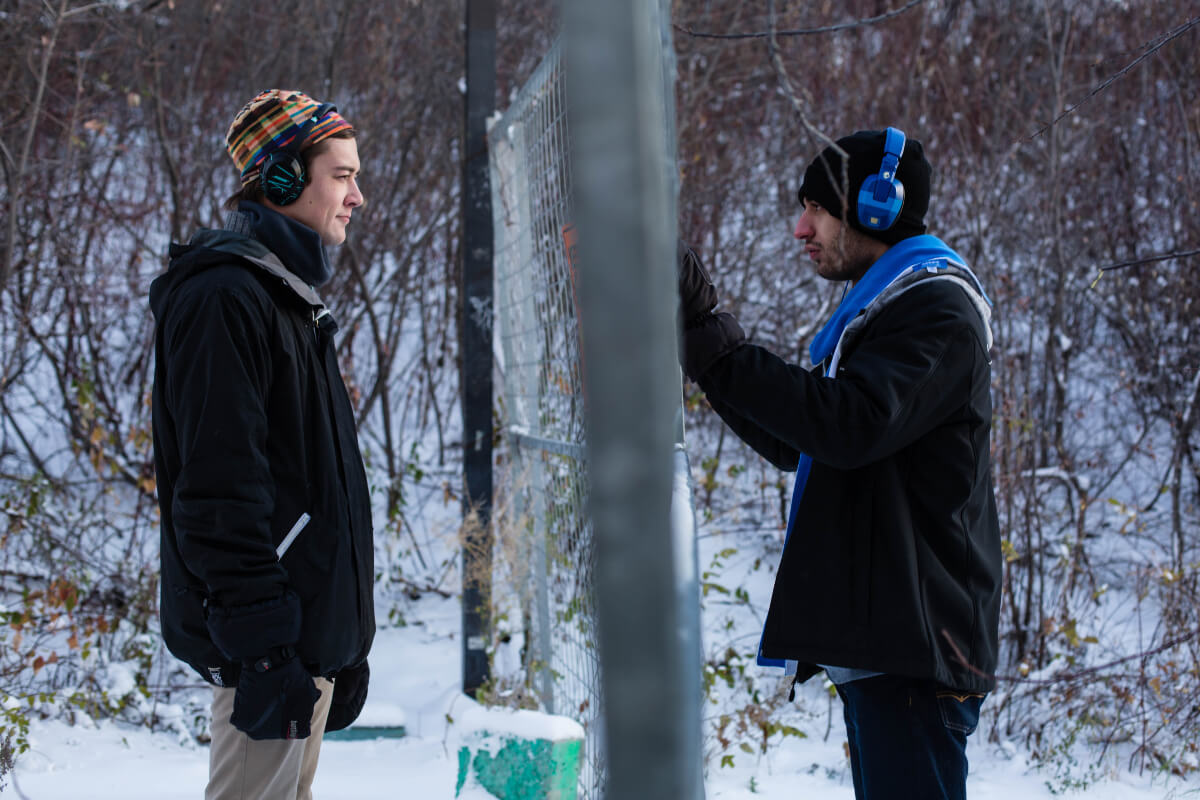When Torien Cafferata was asked how he met Amberlin Hsu, his co-founder of It’s Not A Box immersive theatre company, the first thing Cafferata did was chuckle.
Amberlin Hsu and Cafferata met while they were both students in the University of Saskatchewan’s drama department. Hsu was a design student while Cafferata was in theatre.
“We both quickly realized… that we’re both kind of weirdos,” Cafferata finally replied. “It’s really easy to spot in the Prairies, when someone else also doesn’t fit in. So we decided to start a company together because we both wanted to make work that was interactive — where the audience is being invited to do something in the space.”
Immersive Theatre Company Asks Viewers to Be Participants
What the duo created was It’s Not a Box Theatre. Formed in 2015, the independent, Saskatoon-based theatre company focuses on interactive and technologically immersive theatre. Although it may be uncommon, immersive theatre is an industry that’s as old as Nokia phones — it’s been around for decades. It’s also a medium that asks viewers to participate in the experience, in much the same way that Charades or murder mystery parties require friends and family to immerse themselves in play and pretend.
The theatre company’s piece Isolata is currently available for anyone to view on their website. Isolata is part of a series of web-based interactive audio games that are designed to be experienced entirely in the viewer’s home. All the viewer needs are a smartphone and a few household items to engage in a one or two-player ghost ritual.
Audience Can Participate in Immersive Theatre From Home
“We’ve always tried to keep some essence of live-ness present,” Cafferata says. “If you’re alone in your house and you’re doing Isolata and it’s a ghost ritual and you’re by yourself, you could say that’s not live. To me there’s a liveness… because at any moment, something could go wrong — at any moment, you could succeed or fail.”
Play Win Fail is a production from 2020 that is described as a “live-action video game.” The piece saw Cafferata don a helmet with a video camera attached and walk around Saskatoon. The audience was able to see where he was going through a live stream and give him directions. In the recording, an audience member asks him to say hello to a stranger passing on the street — he gives a hi and waves, much to the stranger’s bafflement, while the audience laughs, and then directs him to go left and check out a playground.
“It’s always been our goal to ask, ‘What are all the ways we haven’t seen plays be done? Can we make it work?’” Cafferata says. “In school, we saw a bunch of plays that were traditional, well-made plays. We know what that looks like and I still appreciate that type of theatre — when it’s pushed to the limit and it’s well done.”
Newest Production Combined Dance, Movement and Ambient Audio
The company just returned from a stint in Vancouver, where they co-produced their piece Re:Place with The Body Orchestra Collective. The piece combined dance and movement with ambient audio that mixed an original score and spoken word poetry.
“As the audience was watching the dance solo, there’s audio in their ears, cued by an app,” explained Cafferata. “So they’re all listening to the same thing at the same time.” The audio was also impacted by spatial kinetics; as the audience moved from one dance space to another or moved their device, the audio would slightly change to reflect those movements or motions.

Challenging the Definition of ‘Real Theatre’
Cafferata says their productions may not be considered theatre at all. Many still see theatre as a passive experience — sitting in a large, dim theatre, while actors cavort on-stage.
“It’s really easy to take a look at this and go, ‘That’s not theatre!’” laughed Cafferata. “We’re slowly starting to do more and more things that aren’t theatre. We’re trying to find all the ways of doing theatre that isn’t theatre. At some point, I’m sure some people will look at us and say we’re not a real theatre company.”
That fact doesn’t really bother him: “To me, a sign of an artist isn’t worrying about what to call things, although that is a question when it comes to marketing. For the most part, it’s up to everyone else to call it things. You just make it and see where society puts you. Sometimes they’ll put you in a shitty place and sometimes they’ll be confused for a long time. And that’s fine.”
Moving Away From Traditional Performance
One of the things that can make audience members hesitant about the theatre company’s performances is the uncertainty of not knowing. The movement away from traditional on-stage performances changes the rules of engagement for people, which can potentially create uncertainty and even a little fear.
“It’s about not knowing the rules,” Cafferata says. “If I invited someone to play a game with me and my friends and we’ve all played but they haven’t, there’s a social block of that person thinking, ‘I don’t speak the same language. I’m worried about ruining the experience.’”
That fear of ruining the experience, either for oneself or everyone else participating, is one that Cafferata thinks can be easily overcome in the same way people eventually join in on Charades; they see the rules are not as complicated as they might think and that doing something poorly only adds to the sense of fun.
“If you can teach the rules the same way a good game does and tutorialize the rules, in safe environments, and make it fun, make it playful, then you can do the same thing that murder mysteries have done and in a much shorter amount of time than you think,” he says. “All of us remember playing games as children and using that to get to know each other and understand our reality.”
Creating Accessible Performances
Another aspect of the company that also goes against the norm is the accessibility of their performances, both physically and financially.
“All of our shows and works — this is one of our values — have been pay what you decide or straight-up free because we want to make things as accessible as possible,” Cafferata says.
For those interested in exploring more of their work, Overhear Solo is another production available to play on their website. If viewers enjoy what they find, there is a donation button on the website to help cover costs. The company has recently received funding for a larger project, due to make its way to public audiences by next summer, with several other collaborations also in the works.
More Great toast Stories
Looking for more arts and culture stories? We’ve got you covered:
- 5 Canadian arts institutions you should know about
- Meet these emerging Canadian visual artists
- Don’t miss the best summer books of 2021
- Netflix movies: 5 hidden gems to watch tonight
Lead photo credit It’s Not a Box Theatre: Two audience members take part in an iteration of It’s Not A Box Theatre’s production “Overhear” during winter 2017.





